Unlocking the Art of Mexican Cuisine With A Cast Iron Tortilla Comal
Cooking with a cast iron tortilla comal is the key to experiencing the true flavors and traditions of Mexican cuisine. This cherished tradition in Mexican cooking involves the use of a comal, a flat plate or griddle, typically made of cast iron. The comal is not just any ordinary cooking utensil – it is a vital tool for making tortillas, sopes, quesadillas, and other masa-based foods.
Thank you for reading this post, don't forget to subscribe!
Comales come in various materials including clay, aluminum, and non-stick options, but the cast iron comal is highly regarded and often passed down through generations. With its excellent heat distribution and retention, cast iron comales are perfect for charring vegetables and spices, toasting seeds and nuts, and cooking a wide range of ingredients. When used for cooking, comales infuse food with a rustic griddle flavor, enhancing the overall taste and texture.
Authentic cast iron tortilla comales can be found in international, Asian, and Latin stores, or they can be substituted with any cast iron plate or heavy skillet. Those seeking a more traditional cooking experience can explore Mexican clay comales, which offer slow heat distribution and retention, or consider using carbon steel comales for their lightweight and practical features.
Regardless of the type of comal used, it is essential to season it before initial use to prevent sticking and enhance flavor. Proper care and storage are also necessary to maintain the quality and longevity of the comal, ensuring it continues to impart its unique flavors to Mexican dishes for years to come.
- Cooking with a cast iron tortilla comal is a vital part of Mexican cuisine, adding authenticity and depth of flavor to dishes.
- Cast iron comales are highly valued and can be passed down through generations.
- Mexican clay comales offer slow heat distribution and retention, while carbon steel comales are lightweight and practical.
- Seasoning and proper care are essential to prevent sticking and maintain the quality of the comal.
- Using a cast iron tortilla comal is a way to preserve and celebrate Mexican culinary heritage.
The Versatility of a Cast Iron Tortilla Comal
A cast iron tortilla comal is a versatile cooking tool that can be used to make not only tortillas but also sopes, quesadillas, and more. Its flat plate design and excellent heat retention make it ideal for achieving the perfect texture and flavor in these traditional Mexican dishes. Whether you’re a seasoned chef or an amateur cook, a cast iron tortilla comal is a must-have in your kitchen.
One of the great things about using a cast iron tortilla comal is that it allows you to experiment with different fillings and flavors. You can create delicious and unique combinations by adding ingredients like cheese, meats, beans, or vegetables to your tortillas, sopes, or quesadillas. The even heat distribution of the comal ensures that all the ingredients are cooked to perfection, resulting in a mouthwatering meal that will impress your family and friends.
Using a cast iron tortilla comal also gives you the freedom to cook outdoors. Whether you’re camping or having a backyard barbecue, this versatile tool is perfect for cooking over an open fire or on a grill. Its durability and heat retention capabilities make it the perfect companion for outdoor cooking adventures.
So, whether you’re craving traditional Mexican cuisine or want to get creative with your cooking, a cast iron tortilla comal is a must-have tool in your kitchen. Its versatility, durability, and ability to add depth of flavor to your dishes make it an essential tool for any culinary enthusiast. Start exploring the world of authentic Mexican cuisine today!
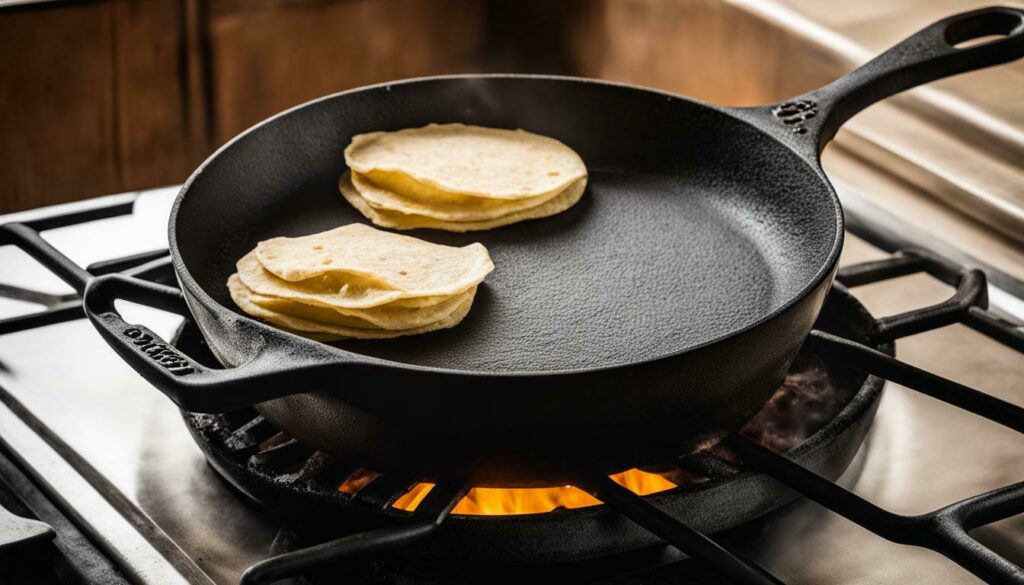
- Tortillas de Maíz: The classic corn tortillas are a staple in Mexican cuisine. With a cast iron tortilla comal, you can achieve the perfect char and texture for the ultimate homemade tortillas.
- Sopes: These thick corn masa cakes topped with beans, meat, cheese, and salsa are a delight to the taste buds. Use your cast iron tortilla comal to create the crispy base for your sopes.
- Quesadillas: Who doesn’t love a cheesy quesadilla? Use your cast iron tortilla comal to cook the tortillas and melt the cheese to gooey perfection.
With these recipes and many more, a cast iron tortilla comal will become your go-to tool for all your Mexican cooking adventures. Enjoy the rich flavors and authentic taste that can only be achieved with this traditional cooking method.
| Advantages of a Cast Iron Tortilla Comal | Disadvantages of other Comales |
|---|---|
| Excellent heat retention | Less durable than cast iron |
| Ability to create a rustic griddle flavor | Poor heat distribution |
| Versatility in cooking different dishes | Non-stick coatings may wear off over time |
The Value of Traditional Cast Iron Comales
Traditional cast iron comales hold a significant place in Mexican culinary heritage, especially when it comes to the art of making authentic, flavorful tortillas. These flat plates or griddles are made of durable cast iron, known for its excellent heat retention and distribution. The comal’s thick, heavy construction allows for even cooking, resulting in perfectly cooked tortillas with a rustic griddle flavor.
Comales are not limited to tortilla-making alone. They are versatile cooking tools that can be used for various purposes in the kitchen. Whether you’re charring vegetables and spices, toasting seeds and nuts, or cooking other masa-based dishes like sopes and quesadillas, a cast iron comal is the go-to tool for achieving exceptional results.
Beyond their practical use, traditional cast iron comales hold sentimental value for many Mexican families. Passed down through generations, these comales carry the memories and flavors of countless meals shared with loved ones. The connection to cultural heritage and the art of traditional cooking is cherished, making the cast iron comal an indispensable part of the Mexican kitchen.
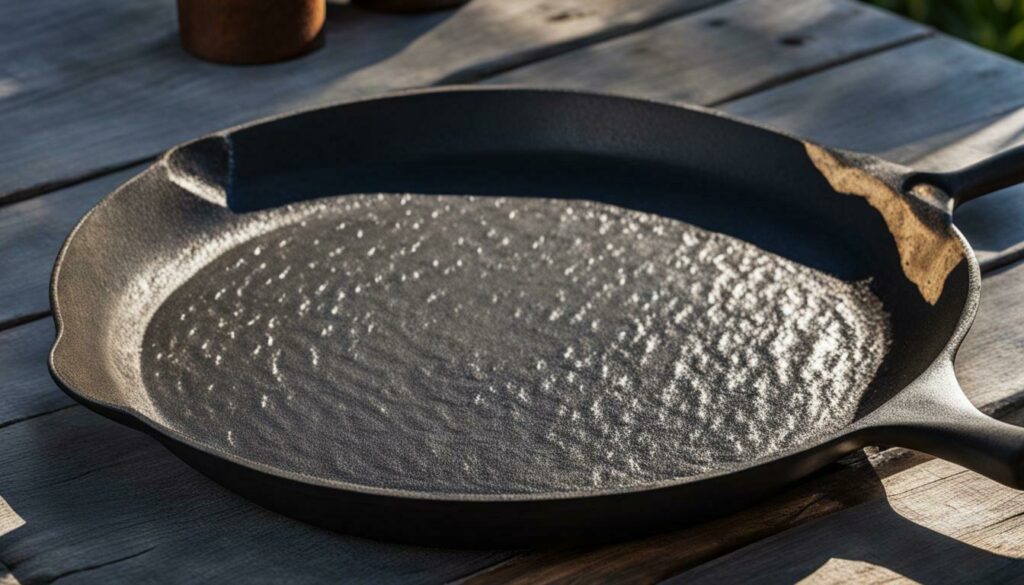
While cast iron comales are the most common and revered, other options such as clay and carbon steel comales are also available. Mexican clay comales offer slow heat distribution and retention, which can be ideal for certain delicate dishes. On the other hand, carbon steel comales are lightweight and practical for everyday use.
Regardless of the type of comal chosen, seasoning is essential to prevent sticking and enhance the flavor of the food prepared on it. With proper seasoning and care, a cast iron comal can last for generations, preserving the rich culinary heritage and traditions of Mexican cuisine.
Seasoning and Care Tips for Cast Iron Comales
To ensure your cast iron comal maintains its quality over time, follow these simple steps:
- Before first use, wash the comal with warm water and mild soap, then dry it thoroughly.
- Coat the comal with a thin layer of vegetable oil or shortening.
- Heat the comal on medium-high heat for 15-20 minutes to allow the oil to penetrate the surface.
- Remove the comal from heat and let it cool completely. Wipe away any excess oil.
Cleaning a cast iron comal should be done with caution to avoid damaging the seasoning. After each use, gently scrub the comal with a soft brush or sponge and warm water. Avoid using soap or harsh abrasives that may strip away the seasoning. Dry the comal thoroughly and apply a light coat of oil to prevent rust.
By properly seasoning and caring for your cast iron comal, you’ll be able to enjoy its authentic cooking capabilities for years to come, imparting the unique depth of flavor that only a traditional, well-seasoned comal can create.
Exploring Different Types of Comales
There are various types of comales to choose from, ranging from cast iron cooking griddles to specialized Mexican tortilla comals, each with its own distinct qualities. Let’s take a closer look at some of the most popular options:
Cast Iron Cooking Griddles
Cast iron cooking griddles, like the one pictured below, are a versatile choice for both indoor and outdoor cooking. They provide even heat distribution and retention, making them ideal for cooking tortillas, sopes, and other masa-based foods. Cast iron comales are known for their durability and the rustic flavor they impart to dishes. They can be used on stovetops, grills, or open flames, making them a favorite among cooking enthusiasts.
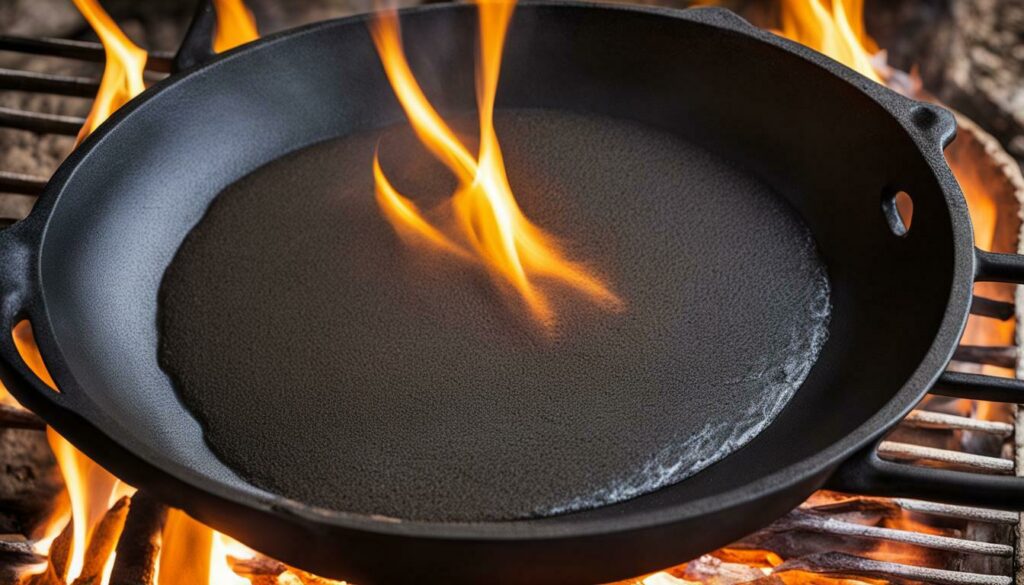
Mexican Tortilla Comals
Mexican tortilla comals are specifically designed for cooking tortillas. They are typically smaller in size compared to cooking griddles, allowing for easy handling and flipping of tortillas. These comals are flat, often with a slightly curved lip to prevent tortillas from slipping off.
They may feature decorative designs or patterns, adding an aesthetic touch to the cooking process. Mexican tortilla comals are cherished for their ability to create perfectly cooked tortillas with a desirable texture and flavor.
While cast iron comales are the most common, there are other options to consider as well, such as clay comales and carbon steel comales. Mexican clay comales offer slow heat distribution and retention, allowing for gentle cooking and enhanced flavors. Carbon steel comales, on the other hand, are lightweight and practical, making them a popular choice for those seeking portability and convenience.
Regardless of the type of comal you choose, it is important to season and care for it properly to prevent sticking and maintain its quality. With proper care and storage, your comal can become a cherished part of your culinary collection, adding a unique depth of flavor to your Mexican dishes.
Seasoning and Care for Cast Iron Comales
Proper seasoning and care are essential when it comes to ensuring the longevity and optimal performance of your cast iron tortilla comal. Seasoning creates a natural non-stick surface on the comal, preventing food from sticking and enhancing its flavor. To season your cast iron comal, follow these simple steps:
- Begin by washing the comal with warm water and a mild dish soap to remove any manufacturing residue.
- Thoroughly dry the comal with a clean cloth or paper towel.
- Apply a thin layer of vegetable oil or shortening to the entire surface of the comal, inside and out.
- Place the comal upside down in an oven preheated to 350°F (175°C).
- Bake the comal for one hour, allowing the oil to penetrate and bond with the cast iron.
- After an hour, turn off the oven and let the comal cool completely inside.
- Repeat this process two or three more times to build up a durable seasoning layer.
Once properly seasoned, your cast iron tortilla comal is ready to use. To maintain its quality and prevent rust, it’s important to follow these care instructions:
- After each use, clean the comal with hot water and a brush or sponge. Avoid using soap, as it can remove the seasoning.
- Dry the comal thoroughly to prevent moisture from causing rust.
- Apply a thin layer of oil before storing the comal to create a protective barrier.
- Store the comal in a cool, dry place.
By properly seasoning and caring for your cast iron tortilla comal, you can enjoy authentic cooking experiences and delicious meals for years to come.
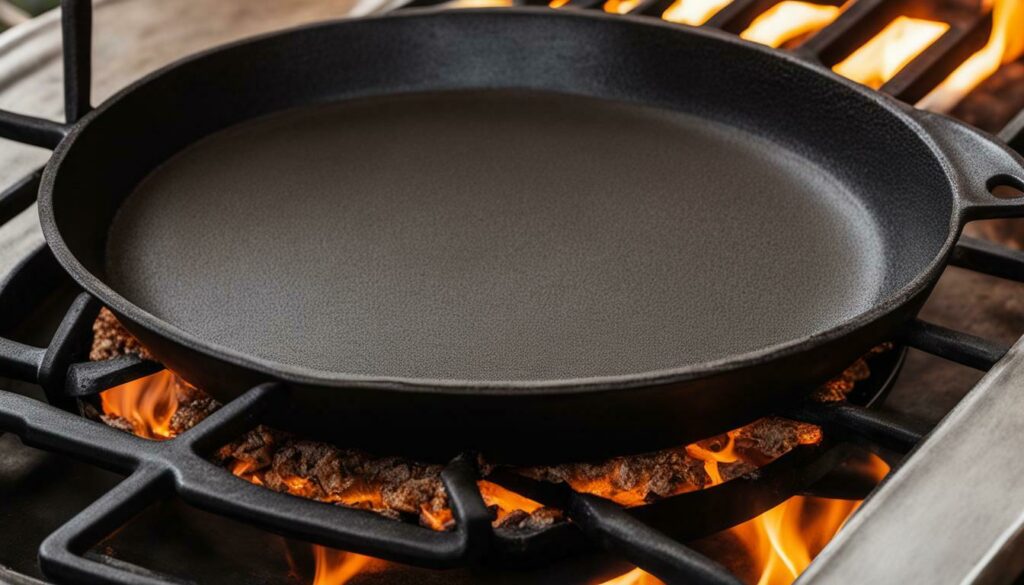
Comparison of Cast Iron, Clay, and Carbon Steel Comales
| Material | Heat Distribution | Weight | Seasoning Required |
|---|---|---|---|
| Cast Iron | Even and consistent | Heavy | Yes |
| Clay | Slow and gradual | Medium | Yes |
| Carbon Steel | Rapid and responsive | Light | Yes |
Exploring Other Comal Options
While cast iron comales are highly valued, there are other options like clay comales and carbon steel comales that offer different benefits and practicality. These alternatives provide chefs and home cooks with additional choices to suit their specific cooking needs and preferences.
Clay Comales: Mexican clay comales have been used for centuries in traditional cooking. They are known for their slow heat distribution and retention, allowing for gentle and even cooking. Clay comales impart a subtle earthy flavor to the food, enhancing the overall taste.
The porous nature of clay helps to absorb excess moisture, resulting in crispy and perfectly cooked tortillas. Additionally, clay comales are aesthetically pleasing and can be used as a serving dish, adding a rustic touch to your table.
Cooking with a clay comal brings back memories of my grandmother’s kitchen. The aroma of freshly made tortillas sizzling on the clay surface is unmatched,” says Maria Rodriguez, a passionate home cook and advocate of traditional cooking methods.
Carbon Steel Comales: For those seeking a lightweight and practical alternative, carbon steel comales are an excellent choice. They heat up quickly and evenly, making them ideal for busy kitchens or outdoor cooking. Carbon steel comales are also durable and have excellent heat retention, allowing for consistent cooking results. With proper care and seasoning, they develop a natural non-stick surface over time, making them convenient to use for a variety of dishes.
| Comal Type | Advantages | Disadvantages |
|---|---|---|
| Cast Iron | Durable and retain heat well | Heavy and require proper maintenance |
| Clay | Slow heat distribution, earthy flavor | Delicate and require careful handling |
| Carbon Steel | Lightweight, quick heat distribution | Require seasoning and maintenance |
When choosing a comal, it’s important to consider your cooking style, preferences, and the type of dishes you plan to prepare. Each comal type has its unique characteristics and benefits, contributing to the overall taste and texture of the food. Whether you opt for cast iron, clay, or carbon steel, proper seasoning and care will ensure longevity and enhance your culinary experience.
So, go ahead and explore the world of comales to add a touch of authenticity and deliciousness to your homemade Mexican dishes.
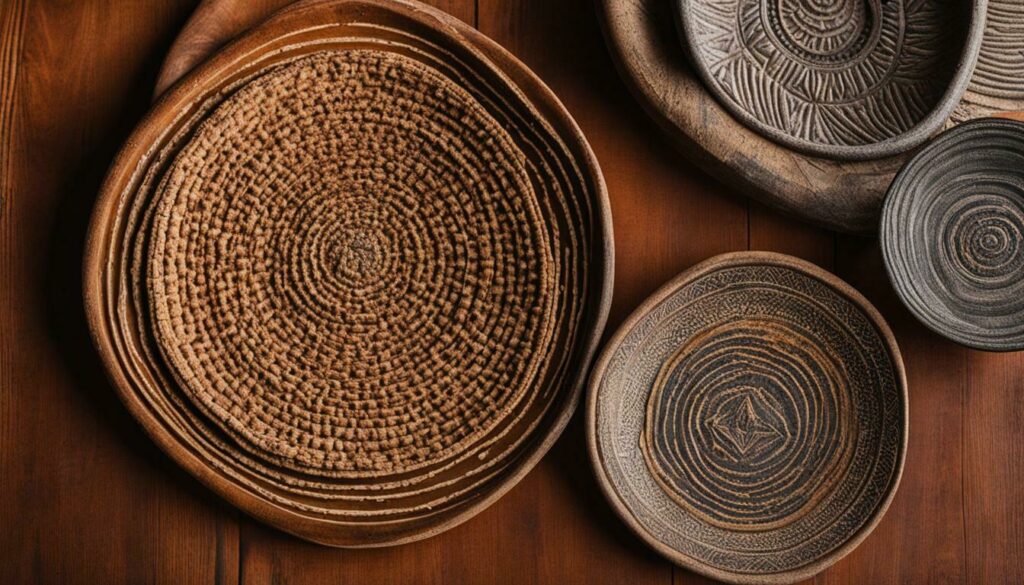
Cooking with a cast iron tortilla comal not only allows you to create authentic Mexican dishes but also infuses them with a distinctive griddle flavor that enhances the overall taste experience. The comal, a cherished tradition in Mexican cuisine, is a flat plate or griddle typically made of cast iron. It is a versatile kitchen tool used for cooking tortillas, sopes, quesadillas, and other masa foods.
While comales can be made from various materials such as clay, aluminum, or non-stick coatings, cast iron comales hold a special place in Mexican culinary heritage. Passed down through generations, these comales are highly valued for their ability to char vegetables and spices, toast seeds and nuts, and cook a variety of ingredients.
Cast iron comales infuse food with a rustic griddle flavor and retain a memory of the flavors from their cooking life. They can easily be found in international, Asian, and Latin stores, or alternatively, you can use any cast iron plate or heavy skillet as a substitute.
If you prefer a different type of comal, Mexican clay comales offer slow heat distribution and retention, while carbon steel comales are lightweight and practical. Regardless of the material, all comales require seasoning before use to prevent sticking and enhance flavor. Proper care and storage are also necessary to maintain the quality and longevity of these cooking tools.
Overall, cooking with a cast iron tortilla comal adds a unique depth of flavor to Mexican dishes and is an important part of Mexican culinary heritage. So, whether you’re making traditional tortillas or exploring other masa-based recipes, using a cast iron tortilla comal will take your cooking to the next level.
FAQ Cast Iron Tortilla Comal
Q: What is a cast iron tortilla comal?
A: A cast iron tortilla comal is a flat plate or griddle, traditionally made of cast iron, used for cooking tortillas, sopes, quesadillas, and other masa foods.
Q: Can I use other types of comales?
A: Yes, comales can be made of clay, aluminum, or non-stick materials, but cast iron comales are highly valued and passed down through generations.
Q: Where can I find a cast iron tortilla comal?
A: Cast iron tortilla comales can be found in international, Asian, and Latin stores, or you can substitute them with any cast iron plate or heavy skillet.
Q: How do I season a cast iron comal?
A: To season a cast iron comal, heat it on low heat, rub it with a thin layer of oil, and let it cool. Repeat this process a few times to create a non-stick surface.
Q: How do I care for a cast iron comal?
A: To care for a cast iron comal, wash it with mild soap and water, dry it thoroughly, and lightly oil it after each use. Avoid using harsh abrasives or soaking it in water.
Q: Are there other types of comales available?
A: Yes, besides cast iron comales, you can explore options such as clay comales, which offer slow heat distribution and retention, and carbon steel comales, which are lightweight and practical.

